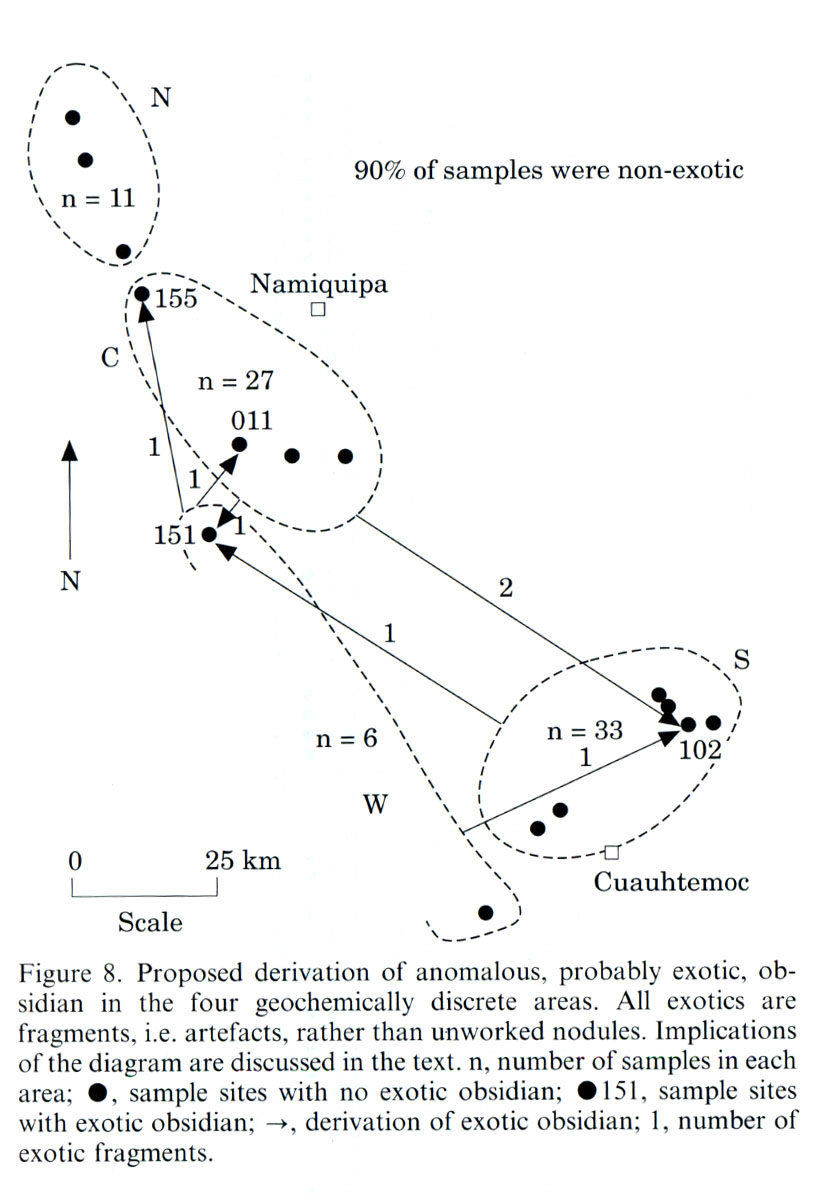
The Silicic Geology of Northwest Mexico, especially Sonora and Chihuahua
As in the Fralick et al. (1998) study in southern Chihuahua, the obsidian sources in northwest Mexico appear to be Tertiary Period sources. No Quaternary, large nodule sources have yet been reported from the region. Indeed, there are few nodules reported over 50-60 mm in diameter, and none of the artifacts thus far analyzed in Chihuahua or Sonora suggest otherwise.
The northern Sierra Madre Occidental is arguably the largest continuous rhyolite field in the world (Cameron et al. 1980). The upper volcanic series of interest here in the Sierra is composed of andesite and rhyolite often forming bimodal volcanic fields dominated by rhyolite (McDowell and Clabaugh 1984). While McDowell and Clabaugh (1984) mainly restricted their work to the Sierra, the sequence is readily applicable to the basin and range region to the east (Fralick et al. 1998). Most of the rhyolite volcanism in the region occurred between 36 and 27 million years ago and is now overlain by 29 to 17 million year old basalt related to crustal extension and Rio Grande rifting (Albrecht et al. 1990; Cameron et al. 1980; Gunderson et al. 1986; McDowell and Mauger 1994). Given the mid-Tertiary origin of rhyolite and thus obsidian, it seems improbable that any large nodule glass sources would remain as discussed in Chapters 2 and 3. Indeed, the relatively great age is one of the factors for the large scale distribution of sources in northern Chihuahuan alluvium and the difficulty of determining the primary sources.
The excellent Fralick et al. (1998) study suggests that while the great time depth of the obsidian in the region and subsequent secondary distribution frustrates precise location of the primary sources, a careful petrological examination of the composition of the obsidian can lead to inferences about the probable primary origin of the raw materials (see figure below). However, as seen in the Cerro Juanequeña and Rio Bavispe studies, 90+% of the obsidian in Chihuahuan and Sonoran sites are non-exotic, that is are locally procured, and those that are exotic are often from only a few tens of kilometers distant. Again, this is in opposition to much of the procurement well known north of the border where fewer sources distributed over the landscape require importation of obsidian as a raw material. One could argue that obsidian provenance studies in much of northwest Mexico will yield little information useful for inferences about exchange or group interaction because procurement is ubiquitously local. At this point in the investigations, however, it would be premature to argue that point.

Fralick et al. map of source assignments in central-southern Chihuahua based on inferred modal compositional histories (1998:1035). Note that 90% of the artifacts are considered local and only a few came from a distance greater than 50 km or so, and those that were from any distance were artifacts not un-reduced (geological) marekanites.
Los Vidrios, Sonora was included in the original published study with the Arizona sources, mainly because it occurs in archaeological contexts in southern Arizona (Shackley 1988, 1995). Another source appears in southern Arizona sites, has not yet been located, but is probably just south of the Douglas, Arizona area and will be discussed here. Antelope Wells (El Berrendo south of the border) as discussed above, is present in primary and secondary contexts in both southwestern New Mexico in the boot heel region, and adjacent Chihuahua (Shackley 1988, 1995).
In the northern Sierra Madre Occidental of the international four-corners region, and the basin and range area region of north-central Chihuahua, an increase in the frequency of archaeological projects has called for a greater understanding of the raw material sources (see Hard and Roney 1999). Unlike the region north of the border, it appears that at least in Chihuahua, the number of compositionally different obsidian sources are seemingly infinite. A number of sources have been located, at least in secondary deposits nearby some of these sites, but few of them have been detected in archaeological contexts – most artifacts are produced from as yet unlocated sources! It may take decades of field survey and mapping to get a grip on the source diversity in Chihuahua and Sonora.
![]() Back to SW Obsidian Sources page
Back to SW Obsidian Sources page
Revised: 21 March 2015